What Is The Size Of A Monarch Butterfly
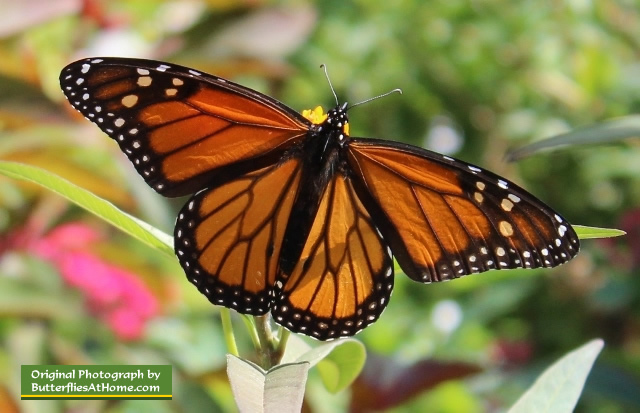
The Monarch is mayhap the all-time known and well-nigh loved butterfly in North America. This large, orange and black butterfly can be seen beyond the country in backyards, parks and fields.
Monarch butterflies (Danaus plexippus) are known for their long-range 3,000 mile mass migration that brings millions of them to California and Mexico each winter.
The Monarch is a large butterfly, with no tails. Information technology has rich orange coloration with black veins, and white spots on the black wing borders and on the torso. Males take small, blackness scent glands on vein in the middle of hind wings. Females have thicker blackness veins.
Its size is in the three.5" - four.0" range.
The Monarch coloration and markings are similar to the Soldier and Viceroy collywobbles.
Monarch collywobbles begin life as eggs and hatch as larvae that eat their eggshells and, later on, the milkweed plants on which they were placed.
Milkweeds and nectar sources are failing due to development and the widespread employ of herbicides in croplands, pastures and roadsides.
Because xc% of all milkweed/Monarch habitats occur inside the agricultural mural, subcontract practices have the potential to strongly influence Monarch populations. Development (subdivisions, factories, shopping centers, etc.) in the U.Southward. is consuming habitats for Monarchs and other wildlife at a charge per unit of half dozen,000 acres per day!
Read more about the status of the Monarch at MonarchWatch.org and nigh Monarch butterfly tagging
The Monarch volition e'er return to areas rich in milkweed to lay their eggs upon the plant. The milkweed they feed on as a caterpillar is actually a poisonous toxin and is stored in their bodies.
This is what makes the Monarch butterfly taste and then terrible to predators. Monarchs can produce four generations during one summer.
The first 3 generations will have life spans from 2 - five weeks and will continue moving north. During this fourth dimension they will mate and have the next generation that will go along the northward migration.
The fourth generation is different and can alive up to nine months.
The migration progresses at a step of 25-30 miles per solar day, although individual collywobbles often fly farther during periods when conditions are favorable.
Well-nigh Monarchs originate from locations more 1,500 miles from the overwintering sites. The duration of the migration appears to exist 2-two.5 months.
Shown below is an identification guide to the female person and male person Monarch Butterfly. Males have pocket-sized, black odour glands on vein in the center of hind wings. Females have thicker blackness veins.


Shown beneath is an identification guide to butterflies that are similar in coloration and markings to the Monarch. Included are the Viceroy, Queen and Soldier ... the "Regal Courtroom" of collywobbles! 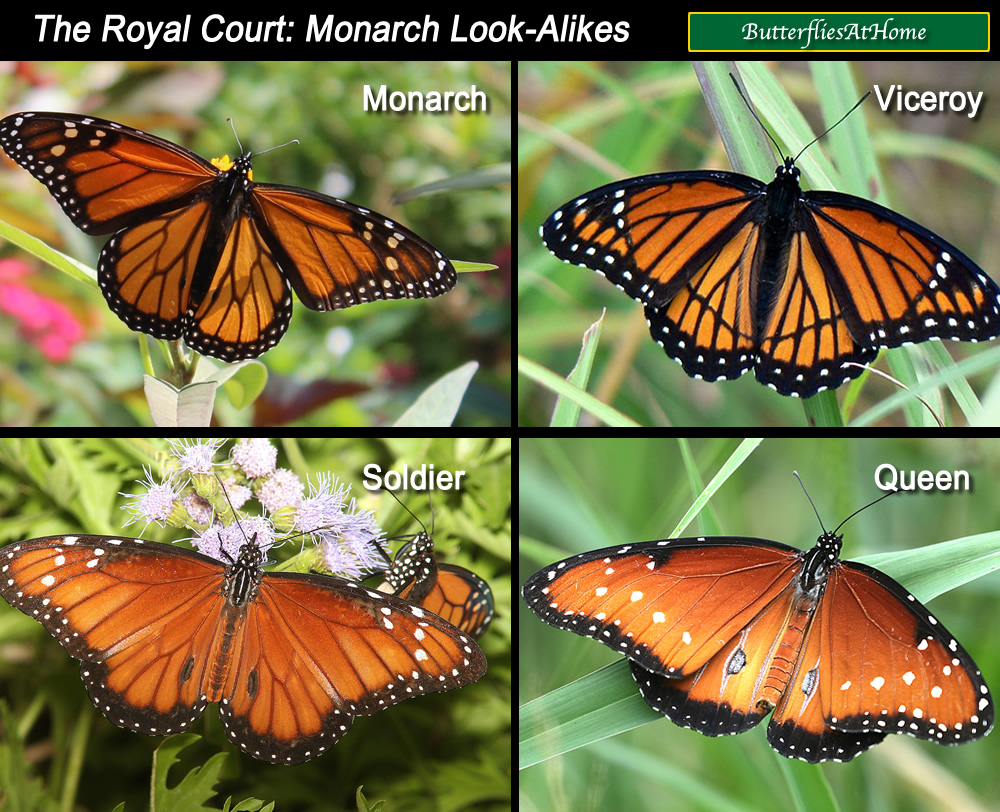

The caterpillars of the Monarch, Queen and Blackness Swallowtail all characteristic white, xanthous and black markings. But which ane are you seeing? Check the images below for the differences between the three caterpillars.
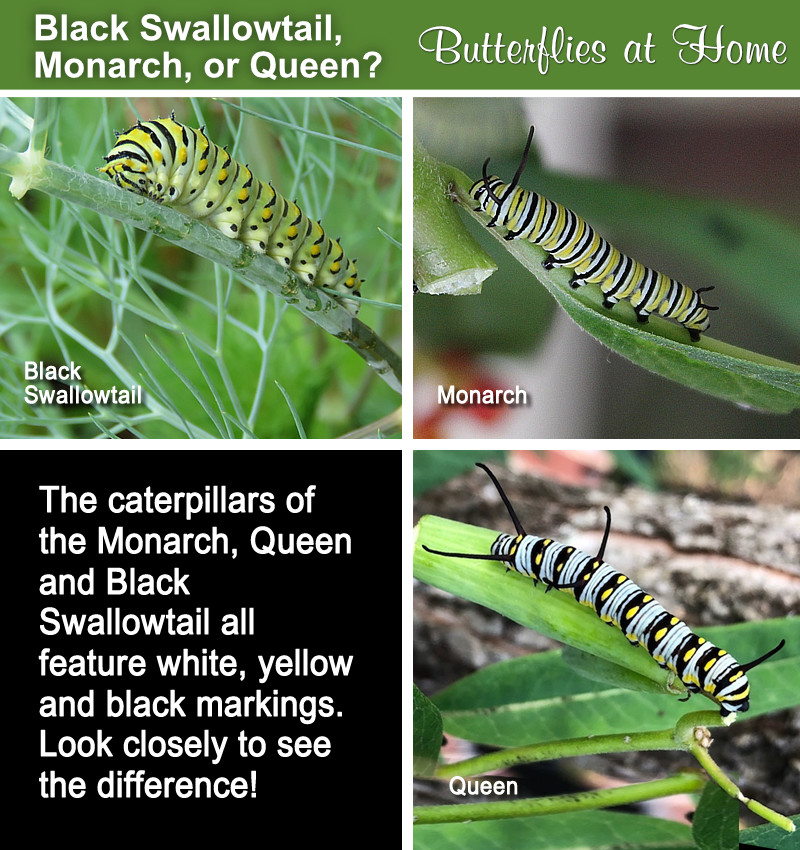

Monarch Butterfly

Rex Butterfly feeding on Lantana

Monarch Butterfly feeding on milkweed ... observe the mature seed pod on the right

Male (50) and female (r) Monarch Butterflies on a pink Zinnia
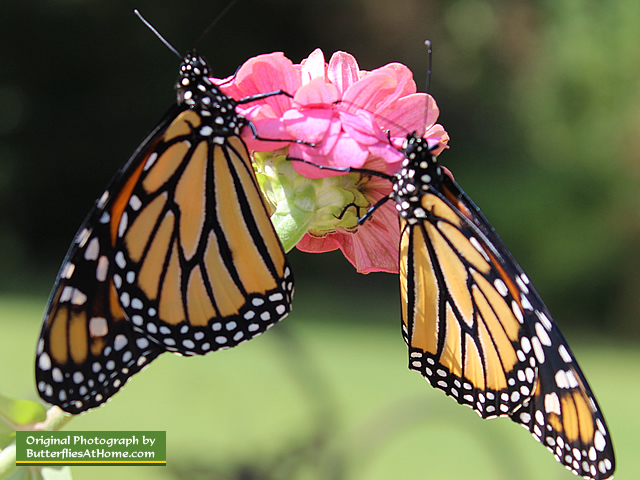
| Monarch Butterfly feeding on milkweed |
| |
| Stage | Typical Duration |
| Egg phase | Generally 4 to 6 days |
| Caterpillar (larval) stage | 2 to three weeks |
| Chrysalis (pupal) stage | 5 to 15 days |
| Adult butterfly stage | 2 to v weeks for the summer generations, but the over-wintering generation in Mexico tin can alive several months |
Monarch Butterfly egg carefully laid in the heart of a Milkweed institute
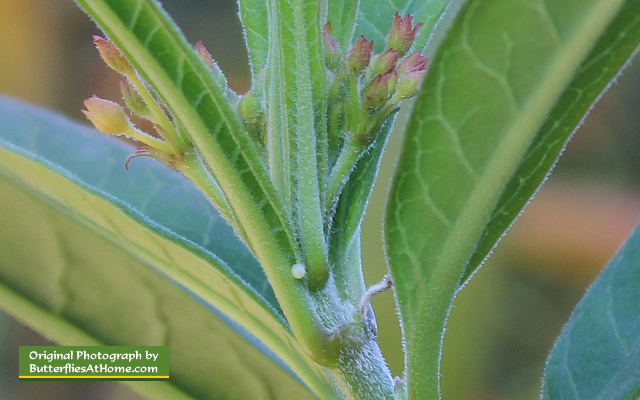
Monarch Butterfly eggs on Milkweed leaves

Monarch Butterfly caterpillar ... right later on hatching, eating its egg casing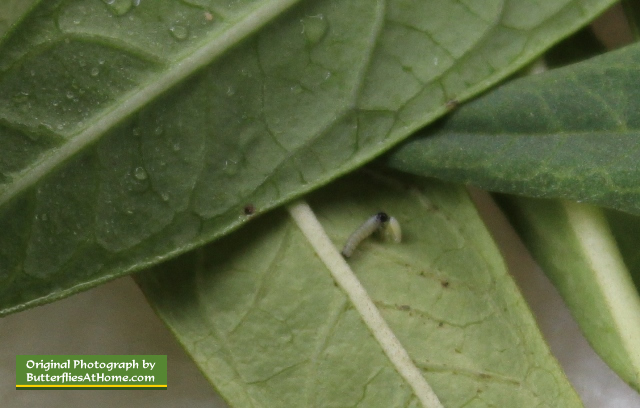 |
Monarch Butterfly caterpillar ... 7 days from egg laying ... size compared to a directly pin
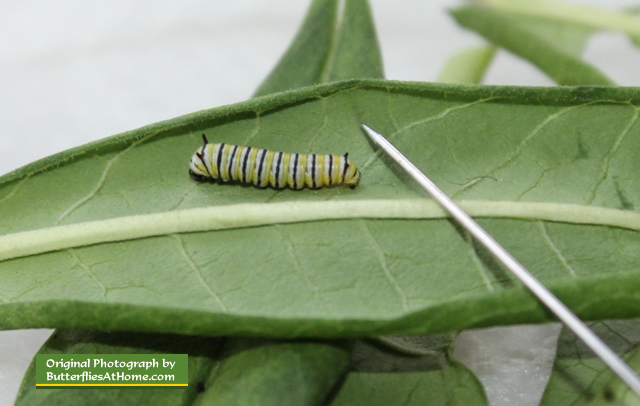
Monarch Butterfly caterpillars ... nearing maturity
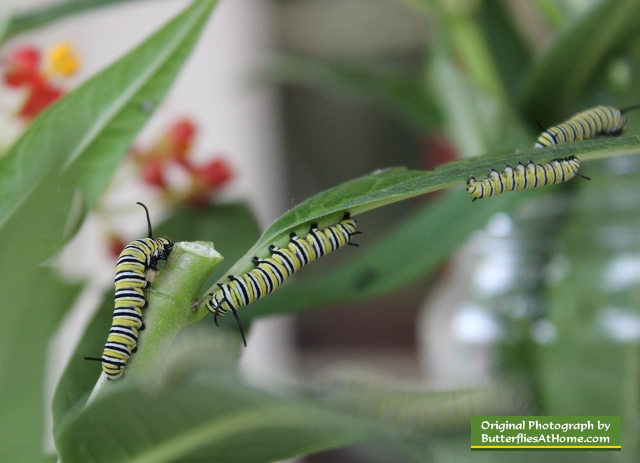
A mature Monarch Butterfly caterpillar roaming on Zinnias, looking for the perfect place to assume the "J" Position

Monarch caterpillar in the "J" position, tail attached to a Milkweed foliage
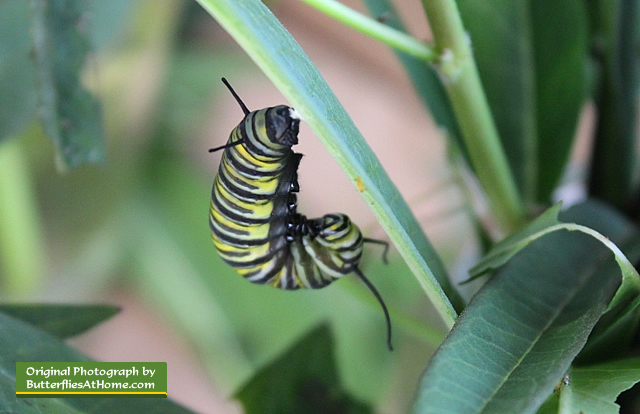
Monarch caterpillar relaxing out of the "J" position, trunk stretched, feelers limp
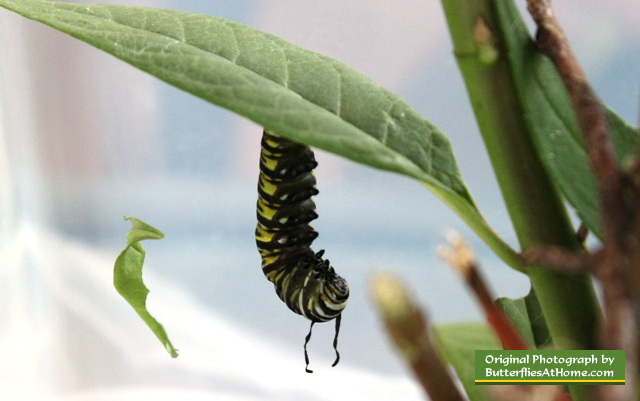
Monarch caterpillar inbound the chrysalis ... it's a quick transformation!
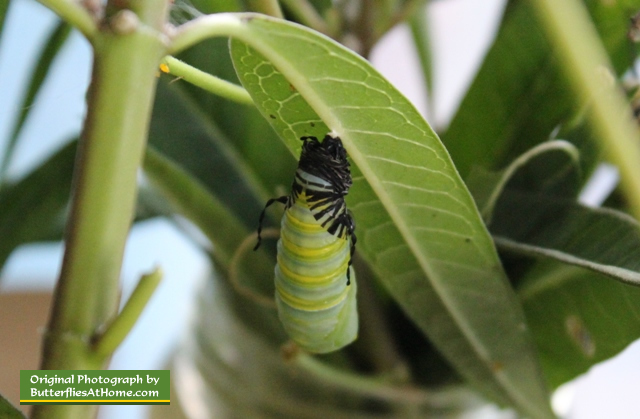
Monarch caterpillar with its chrysalis nearly complete ... the remaining "skin" will soon exist dropped
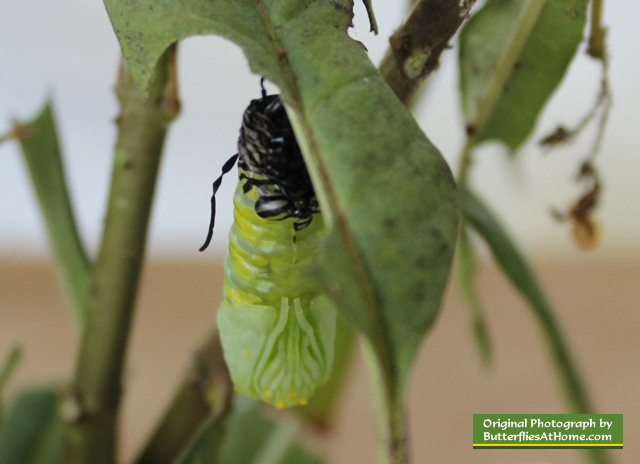
Monarch Butterfly caterpillar in its chrysalis ... advisedly blending with nature!
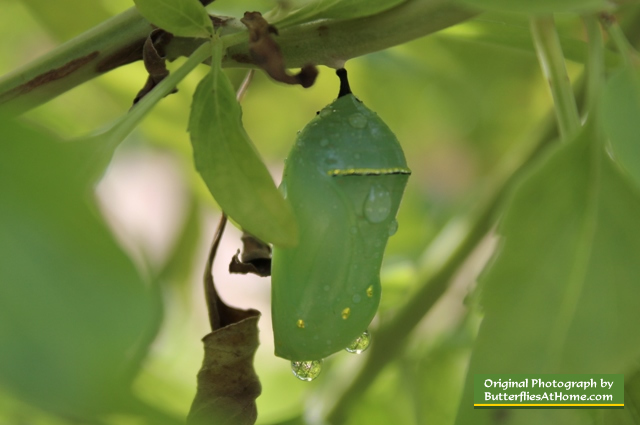
Monarch chrysalis ... night and clear, with the butterfly ready to sally
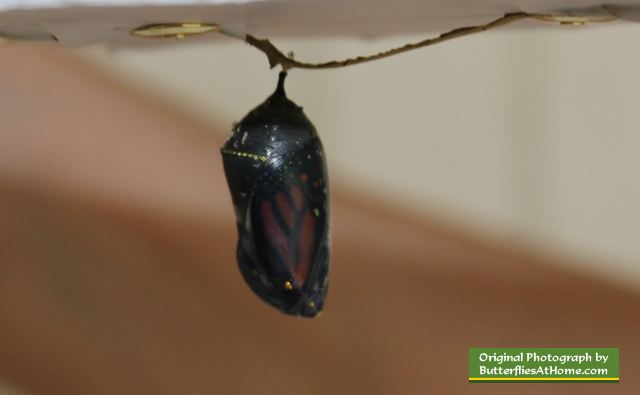
A beautiful new Monarch Butterfly ... minutes afterward eclosing from 10 days in its chrysalis

At the end of 2013, we harvested equally many seeds equally we could from our mature Milkweed plants. In the spring of 2014, nosotros started three flats of these seeds in small peat pots.
Once the seedlings were most 3" in height, they were transplanted across our property, x "hills" of several plants per hill. Other 2013 seeds were distributed to butterfly-friendly family members and friends.
They grew nicely, eventually up to over four anxiety in tiptop. But in the spring we merely saw a couple of Monarchs, headed northeast. And, sadly, we saw none during the summertime. Then, on September 3, we were surprised to see a female Monarch outside our window. She remained for three days, laying eggs on all of the Milkweed across the landscape.
We took in 47 eggs to help insure success of this Monarch. Eventually, 44 hatched in our "incubator" and transformed successfully into beautiful Monarchs which we released in early October. Many other eggs remained in the mural, hatched, and grew into mature caterpillars. Ane attached to a brick wall, one to a metallic BBQ pit (see photos higher up) ... while we were leery of these locations, both turned out to be successful and produced big Monarchs!
Information technology was indeed a family thing! It took five of the states, from three family generations, to make this happen. Information technology was a lot of piece of work to proceed the incubator clean and supplied with fresh Milkweed. And we had to pay meticulous attention to each chrysalis equally it was formed, as the leaves quickly wilted and were are risk to falling. So each was pinned to the acme of the incubator where they could hang safely in a natural, vertical orientation. And of course we had to be wary of the Milkweed itself, and keeping its "milk" off our hands and away from our eyes.
While labor intensive, information technology was a bang-up learning experience for all involved. Plus, we hope in a minor way to have helped stabilize and grow the threatened Monarch population.
| Our Monarch Butterfly "incubator" ... where 44 butterflies were hatched |
| |
| We cleaned the incubator daily, and kept a fresh supply of Milkweed for the caterpillars. At the bottom of the incubator nosotros had chocolate-brown paper numberless. I twenty-four hour period we were surprised to find four perfect chrysalis attached underneath the bag, each lined up perfectly with the next. Nosotros carefully cut the paper, hung it, and all four hatched into beautiful Monarchs! |
| |
| New Monarch Butterflies gear up to fly! |
| |
| A perfect new male monarch Butterfly but eclosed and ready to fly southward in autumn! |
| |
 MonarchWatch.org tags and tagging data sheets
MonarchWatch.org tags and tagging data sheets
Studies continue yearly on the migration patterns of Monarch butterflies. One research tool is tagging, used to associate the location of capture with the betoken of recovery for each butterfly. The data from these recaptures are used to determine the pathways taken by migrating monarchs, the influence of atmospheric condition on the migration, the survival rate of the monarchs, etc.
MonarchWatch.org operates a tagging system in which each tagged butterfly has a tag lawmaking (three letters and 3 numbers). The tags are printed with waterproof ink on polypropylene sheets that take special 3M adhesive on the back. The printed tags are placed on a backing from which they can be easily removed. They are organized in groups of 25 consecutive numbers/tags per sheet.
Read more than about tagging and to order your tags at MonarchWatch.org
Shown below are some of the tags our enthusiastic immature group placed on Monarch caterpillars in October of 2015.

Each jump nosotros start growing new Milkweed plants from seeds harvested from the previous twelvemonth. They spout consistently and grow apace, and are ready for transplanting in about a month. And if the winter is mild, young plants will come upward from the roots of frozen Milkweeds.
Monarch Waystations are places that provide resources necessary for monarchs to produce successive generations and sustain their migration. A waystation can be anywhere ... a habitation lawn, park, schoolhouse or elsewhere.
Without milkweeds throughout their leap and summer breeding areas in Due north America, Monarchs would not be able to produce the successive generations that culminate in the migration each autumn. By creating a Monarch Waystation you tin can assist in Monarch conservation and assistance the preservation of the species.
Nosotros are proud to be certified as Monarch Waystation 8560
read more about how to register your Monarch waystation
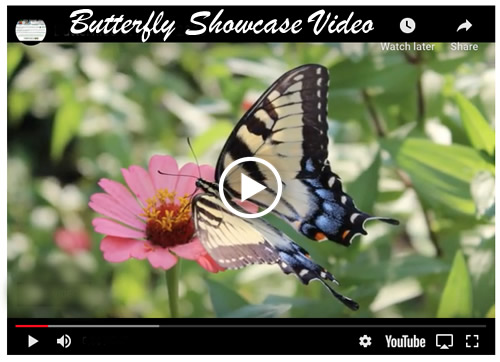
What Is The Size Of A Monarch Butterfly,
Source: https://www.butterfliesathome.com/monarch-butterfly.htm
Posted by: mooreswerown.blogspot.com

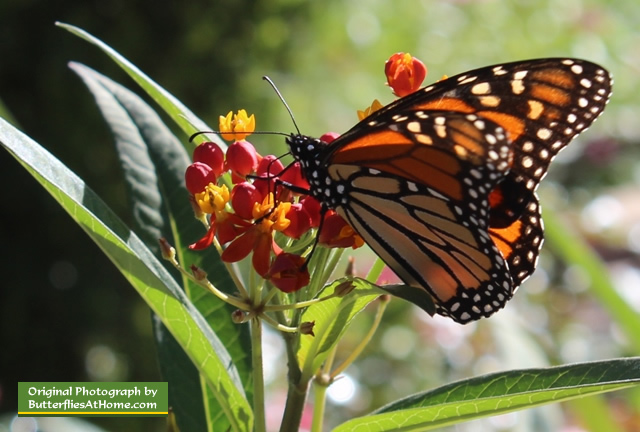

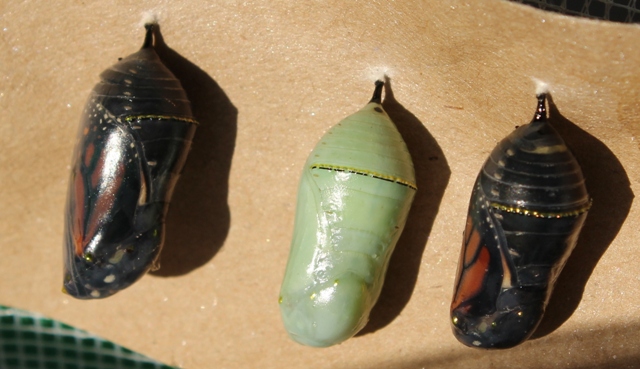

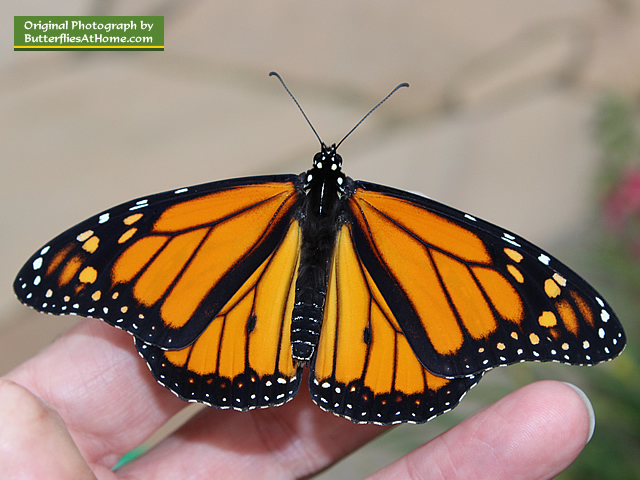

0 Response to "What Is The Size Of A Monarch Butterfly"
Post a Comment